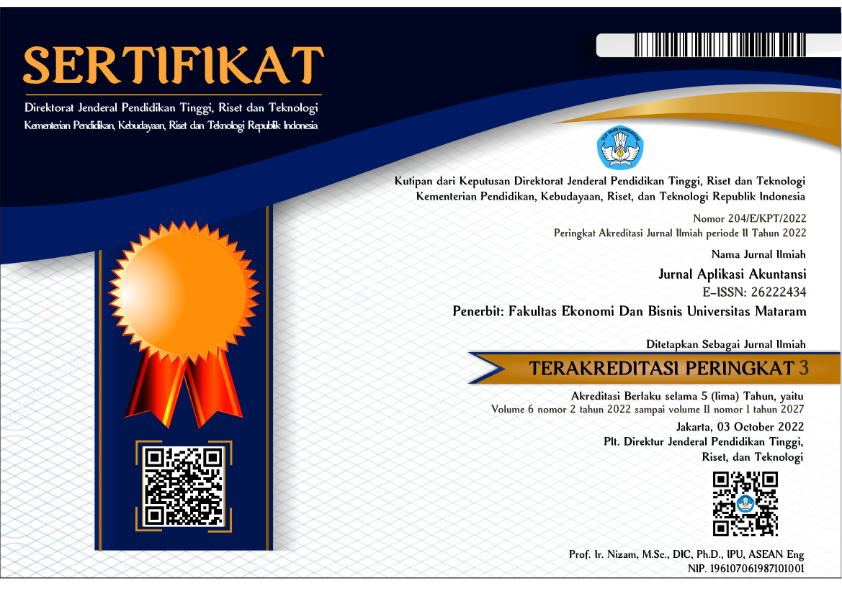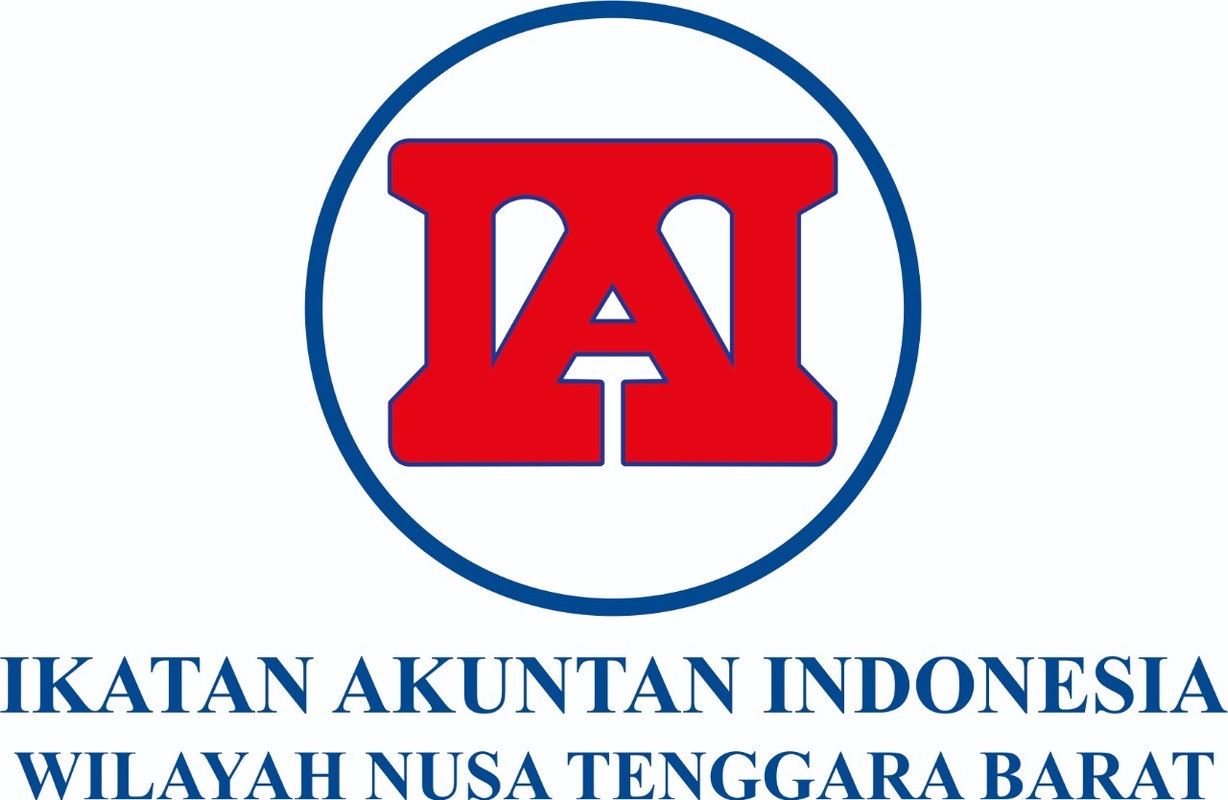EFEK RISIKO BENCANA DAN TEKANAN FISKAL: BAGAIMANA IMPLIKASINYA TERHADAP KUALITAS LINGKUNGAN HIDUP
DOI:
https://doi.org/10.29303/jaa.v8i2.344Keywords:
SEM PLS, tekanan fiskal, risiko bencana, lingkungan hidup, budget deficitAbstract
Tujuan dari penelitian ini adalah untuk mengevaluasi dan menguji hubungan antara tekanan anggaran dan risiko bencana, serta untuk menguji pengaruhnya terhadap kualitas lingkungan. Dalam penelitian ini, metode kuantitatif digunakan untuk mencapai tujuan penelitian. Populasi penelitian ini adalah seluruh pemerintah kabupaten dan kota di Provinsi Aceh. Dengan menggunakan teknik sampling jenuh dan data sekunder ditetapkan sampel penelitian. Laporan bencana dari Badan Penanggulangan Bencana Aceh dan laporan keuangan dari pemerintah daerah menjadi dasar metode dokumentasi data ini. Setelah pengumpulan data, SmartPls 3 digunakan untuk menganalisis data menggunakan PLS Structural Equation Modeling (SEM). Berdasarkan temuan analisis SEM PLS, risiko bencana berdampak signifikan terhadap kualitas lingkungan. Namun tekanan fiskal tidak banyak berpengaruh terhadap keadaan lingkungan. Demikian pula, tidak ada hubungan yang jelas antara risiko bencana dan tekanan fiskal. Temuan uji mediasi menunjukkan bahwa tekanan fiskal tidak dapat memoderasi hubungan antara kualitas lingkungan dan kemungkinan terjadinya bencana. Dengan memasukkan teknik pengurangan risiko bencana ke dalam keuangan daerah dengan tujuan menjaga stabilitas keuangan daerah, maka kontribusi penelitian ini diyakini akan membantu semua pihak yang berkepentingan dalam meningkatkan kualitas lingkungan hidup.
References
Alqahtany, A. M., & Rimi, I. (2020). Public perception and attitudes to disaster risks in a coastal metropolis of Saudi Arabia. January.
Azzahra, L., Pamungkas, P., & Trinarningsih, W. (2022). Application of green budgeting in finance and development policy. 9th International Conference on Sustainable Agriculture and Environment. https://doi.org/10.1088/1755-1315/1114/1/012101
Bosher, L., & Chmutina, K. (2001). Disaster Risk Reduction for the Built Environment. In Bulletin of the Geological Survey of Canada (Issue 548). 7 John Wiley & Sons Ltd. https://doi.org/10.7723/antiochreview.70.2.0256
Buhyoff, G. J. (2003). Understandings of Environmental Quality : Ambiguities and Values Held by Environmental Professionals. Environmental Management, 31(1), 1–13. https://doi.org/10.1007/s00267-002-2812-6
Cardona, O. D., Ordaz, M. G., Marulanda, M. C., Carreño, M. L., & Barbat, A. H. (2010). Disaster risk from a macroeconomic perspective: a metric for fiscal vulnerability evaluation. Disasters, 34(4), 1064–1083. https://doi.org/10.1111/j.1467-7717.2010.01183.x
Chen, B., & Chu, L. (2022). Decoupling the double jeopardy of climate risk and fiscal risk : A perspective of infrastructure investment. Climate Risk Management, 37(January), 100448. https://doi.org/10.1016/j.crm.2022.100448
Conteh, C., Greitens, T. J., Jesuit, D. K., & Roberge, I. (2014). Governance and public management: Strategic foundations for volatile times. Routledge.
Davidsson, Å. (2020). Disasters as an opportunity for improved environmental conditions. International Journal of Disaster Risk Reduction, 48(May 2019), 101590. https://doi.org/10.1016/j.ijdrr.2020.101590
Fahlevi, H., & Syukur, M. (2022). “Same storm, different boats”: the COVID-19 pandemic and its impact on Indonesian public companies. International Journal of Monetary Economics and Finance, 15(5), 508–525. https://doi.org/10.1504/IJMEF.2022.10050763
Fuje, H., Yao, J., Choi, S. M., & Mighri, and H. (2023). Fiscal Impacts of Climate Disasters in Emerging Markets and Developing Economies (WP/2023/261).
Gerling, K. (2017). The Macro-Fiscal Aftermath of Weather-Related Disasters: Do Loss Dimensions Matter? IMF Working Papers, 17(235), 1. https://doi.org/10.5089/9781484326633.001
Ghaderi, Z., Walker, M., & Béal, L. (2022). Responses and Learning From Covid-19: Integrating Chaos and Complexity Theories in the Event and Tourism Sector in Iran. Event Management, 26(8), 1671–1687. https://doi.org/10.3727/152599522X16419948391258
Hadi, S. P., Ibrahim, M. H., Prabawani, B., & Hamdani, R. S. (2021). Environmental dimension of pandemic COVID-19: Case studies of Indonesia. IOP Conference Series: Earth and Environmental Science, 623(1). https://doi.org/10.1088/1755-1315/623/1/012051
Hair, J. F., Risher, J. J., Sarstedt, M., & Ringle, C. M. (2019). When to use and how to report the results of PLS-SEM. European Business Review, 31(1), 2–24.
Hochrainer-stigler, S. (2021). Changes in fi scal risk against natural disasters due to Covid-19. Progress in Disaster Science, 10, 100176. https://doi.org/10.1016/j.pdisas.2021.100176
Islam, S., Chu, C., Smart, J. C. R., & Liew, L. (2019). Integrating disaster risk reduction and climate change adaptation : a systematic literature review. Climate and Development, 0(0), 1–13. https://doi.org/10.1080/17565529.2019.1613217
Kamboj, N., Bisht, A., Kamboj, V., Pandey, N., & Bisht, A. (2020). Role of natural disasters in environmental degradation: An overview. Environmental Degradation: Causes and Remediation Strategies, 21–35. https://doi.org/10.26832/aesa-2020-edcrs-02
Kanchana, G., Amaratunga, Haigh, D., & D, R. (2013). In: 2013 International Conference on Building Resilience. Disaster Risk Reduction in the Built Environment in Sri Lanka- An Overview.
Klioutchnikov, I., Sigova, M., & Beizerov, N. (2017). Chaos Theory in Finance. Procedia Computer Science, 119(2017), 368–375. https://doi.org/10.1016/j.procs.2017.11.196
MacKay, R. C. (2017). The Impact of Fiscal Stress on Local Government Fiscal Structures: An Event Study of the Orange County Bankruptcy. Public Budgeting and Finance, 37(2), 102–124. https://doi.org/10.1111/pbaf.12149
Miao, Q., Hou, Y., & Abrigo, M. (2016). Measuring the Financial Shocks of Natural Disasters : A Panel Measuring the Financial Shocks of Natural Disasters : A Panel Study of U . S . States. 232.
Mukherjee, S., Kar, S., & Pal, S. (2021). Environmental Disaster Management and Risk Reduction. In Environmental Management: Issues and Concerns in Developing Countries (pp. 61–78). https://doi.org/10.1007/978-3-030-62529-0_4
Mullins, D. R., & Pagano, M. A. (2005). Local budgeting and finance: 25 years of developments. Public Budgeting and Finance, 25(4s), 3–45. https://doi.org/10.1111/j.1540-5850.2005.00002.x
Nihayah, D. M., & Diastuti, R. (2023). The Role of Green Budgeting on Environmental Quality on Indonesia. 12(2), 217–230.
Pratibha, A., & Archna, A. (2015). At the Whim of Nature “Natural Disasters”: Causes and Prevention. International Journal of Research -GRANTHAALAYAH, 3(9SE), 1–4. https://doi.org/10.29121/granthaalayah.v3.i9se.2015.3194
Russel, D., & Benson, D. (2014). Green budgeting in an age of austerity: a transatlantic comparative perspective. Environmental Politics, 23(2), 243–262. https://doi.org/10.1080/09644016.2013.775727
Schipper, E. L. F., Thomalla, F., Vulturius, G., Davis, M., & Johnson, K. (2016). Linking disaster risk reduction , climate change and development. International Journal of Disaster Resilience in the Built Environment, 7(2).
Sellnow, T. L., Seeger, M. W., & Ulmer, R. R. (2002). Chaos theory, informational needs, and natural disasters. Journal of Applied Communication Research, 30(4), 269–292. https://doi.org/10.1080/00909880216599
Sen, R., & Chakrabarti, S. (2019). Disaster Management Dynamics – An Analysis of Chaos from the Flash Flood (2013) in the Fragile Himalayan System. Journal of the Geological Society of India, 93(3), 321–330. https://doi.org/10.1007/s12594-019-1180-2
Shi, P., Ye, T., Wang, Y., Zhou, T., Xu, W., Du, J., Wang, J., Li, N., Huang, C., Liu, L., Chen, B., Su, Y., Fang, W., Wang, M., Hu, X., Wu, J., He, C., Zhang, Q., Ye, Q., … Okada, N. (2020). Disaster Risk Science: A Geographical Perspective and a Research Framework. International Journal of Disaster Risk Science, 11(4), 426–440. https://doi.org/10.1007/s13753-020-00296-5
Steiner, A. (2008). Environment and Disaster Risk Emerging Perspectives. United Nations Environment Programme.
Su, Q., Chen, K., & Liao, L. (2021). The impact of land use change on disaster risk from the perspective of efficiency. Sustainability (Switzerland), 13(6), 1–14. https://doi.org/10.3390/su13063151
Sun, Y., Zhu, D., Zhang, Z., & Yan, N. (2022). Does fiscal stress improve the environmental efficiency? Perspective based on the urban horizontal fiscal imbalance. International Journal of Environmental Research and Public Health, 19(10), 6268.
Tran, P., & Shaw, R. (2012). Environment disaster linkages: An overview. In Community, Environment and Disaster Risk Management (Vol. 9). Emerald Group Publishing Ltd. https://doi.org/10.1108/S2040-7262(2012)0000009007
UNISDR. (2009). UNISDR Terminology on Disaster Risk Reduction 2009. In HUnited Nations International Strategy for Disaster Reduction. https://doi.org/10.7591/9781501701498-008
Wildasin, D. E. (2006). Disasters: Issues for State and Federal Government Finances. 1–35. http://martin.uky.edu/sites/martin.uky.edu/files/IFIR/Pub/IFIR-WP-2006-07.pdf
Wiyanti, A., & Halimatussadiah, A. (2021). Are Disasters a Risk to Regional Fiscal Balance? Evidence from Indonesia. International Journal of Disaster Risk Science, 12(6), 839–853. https://doi.org/10.1007/s13753-021-00374-2
Yin, G., & Herfel, W. (2011). CONSTRUCTING POST-CLASSICAL ECOSYSTEMS ECOLOGY. In Philosophy of Complex Systems (Vol. 10). Elsevier B.V. https://doi.org/10.1016/B978-0-444-52076-0.50014-6
Zenker, S. (2020). The coronavirus pandemic – A critical discussion of a tourism research agenda. Tourism Management, 81. https://doi.org/10.1016/j.tourman.2020.104164
Zhang, Z., & Zhao, W. (2018). Research on Financial Pressure , Poverty Governance , and Environmental Pollution in China. https://doi.org/10.3390/su10061834
Downloads
Published
How to Cite
Issue
Section
License
Copyright (c) 2024 Lilis Marlina, Linda Rahmazaniati, Rina Maulina

This work is licensed under a Creative Commons Attribution-NonCommercial-ShareAlike 4.0 International License.









